GRAPHING RATIONAL FUNCTION EXAMPLES
Subscribe to our ▶️ YouTube channel 🔴 for the latest videos, updates, and tips.
To know about continuity, holes, vertical asymptotes, horizontal asymptotes, and domain. Click on the link
Identify the points of discontinuity, holes, vertical asymptotes, x – intercepts, horizontal asymptote, and domain of each. Then sketch the graph.
Example 1 :
f(x) = (x2 - 7x + 12)/(-2x2 - 2x + 24)
Solution :
Discontinuity :
f(x) = (x2 - 7x + 12)/(-2x2 - 2x + 24)
= (x2 - 7x + 12)/-2(x2 + x - 12)
By factoring,
x2 - 7x + 12 = (x – 3) (x – 4)
2(x2 + x – 12) = (x - 3) (x + 4)
f(x) = (x – 3) (x – 4)/(x - 3) (x + 4)
x - 3 = 0 and x + 4 = 0
x = 3 and x = -4
The function is discontinuous at x = 3 and x = -4.
Holes :
The common factor is (x - 3).
x – 3 = 0
x = 3
So, there is a hole at x = 3.
Vertical asymptote :
x + 4 = 0
x = -4
So, the vertical asymptote at x = -4.
X – intercepts :
f(x) = (x – 3) (x – 4)/(x - 3) (x + 4)
X – intercepts occurs when y = 0.
f(0) = (x - 4)/(x + 4)
x - 4 = 0
x = 4
So, the x – intercepts is 4.
Horizontal asymptote :
f(x) = (x2 - 7x + 12)/-2(x2 + x - 12)
degree
of numerator = degree of denominator
y = leading coefficient of N(x)/leading coefficient of D(x).
= 1/-2
So, equation of the horizontal asymptote is y = -1/2.
Domain :
When x - 3 = 0 and x + 4 = 0
x = 3 and x = -4
So, all real values except 3 and -4.
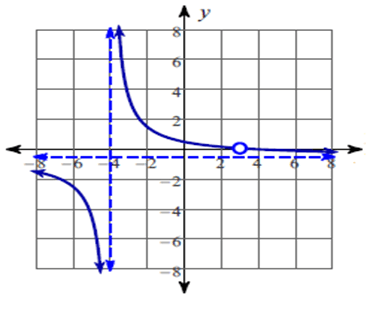
Example 2 :
f(x) = (3x2 - 3x - 18)/(x2 - 4)
Solution :
Discontinuity :
f(x) = (3x2 - 3x - 18)/(x2 - 4)
By factoring,
3x2 - 3x – 18 = 3(x2 – x – 6)
3(x2 – x – 6) = 0
x2 – x – 6 = (x + 2) (x – 3)
x2 – 4 = (x + 2) (x – 2)
f(x) = (x + 2) (x – 3)/(x + 2) (x – 2)
(x + 2) (x – 2) = 0
x + 2 = 0 and x – 2 = 0
x = -2, x = 2
The function is discontinuous at x = 2 and x = -2.
Holes :
The common factor is (x + 2).
x + 2 = 0
x = -2
So, there is a hole at x = -2.
Vertical asymptote :
x – 2 = 0
x = 2
So, the vertical asymptotes at x = 2.
X – intercepts :
f(x) = (3x2 - 3x - 18)/(x2 - 4)
X – intercepts occurs when y = 0.
f(0) = (3x2 – 3x - 18)/(x2 - 4)
x - 3 = 0
x = 3
So, the x – intercepts is 3.
Horizontal asymptote :
f(x) = (3x2 - 3x - 18)/(x2 - 4)
degree
of numerator = degree of denominator
y = leading coefficient of N(x)/leading coefficient of D(x).
= 3/1
So, equation of the horizontal asymptote is y = 3.
Domain :
When x2 - 4 = 0
(x + 2) (x – 2) = 0
x + 2 = 0 and x – 2 = 0
x = -2 x = 2
So, all real values except -2 and 2.
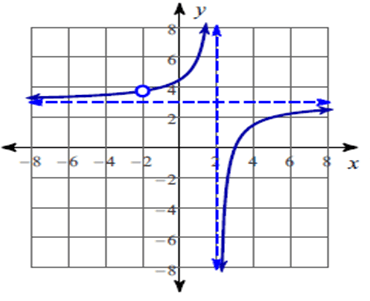
Example 3 :
f(x) = (x2 + 6x + 8)/(x2 + 3x - 4)
Solution :
Discontinuity :
f(x) = (x2 + 6x + 8)/(x2 + 3x - 4)
By factoring,
x2 + 6x + 8 = (x + 2) (x + 4)
x2 + 3x – 4 = (x + 4) (x – 1)
f(x) = (x + 2) (x+ 4)/((x + 4) (x – 1)
x + 4 = 0 and x – 1 = 0
x = -4 x = 1
The function is discontinuous at x = -4 and x = 1.
Holes :
x + 4 = 0
x = -4
So, there is a hole at x = -4.
Vertical asymptote :
x – 1 = 0
x = 1
So, the vertical asymptotes at x = 1.
X – intercepts :
f(x) = (x + 2) (x + 4)/(x + 4) (x – 1)
X – intercepts occurs when y = 0.
0 = (x + 2)/(x – 1)
x + 2 = 0
x = -2
So, the x – intercepts is -2.
Horizontal asymptote :
f(x) = (x2 + 6x + 8)/(x2 + 3x - 4)
degree of numerator = degree of denominator
y = leading coefficient of N(x)/leading coefficient of D(x).
So, equation of the horizontal asymptote is y = 1.
Domain :
When x + 4 = 0 and x - 1 = 0
x = -4 and x = 1
So, all real values except -4 and 1.
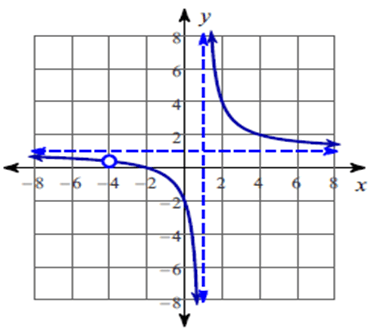
Example 4 :
f(x) = (2x + 6)/(x2 + 5x + 6)
Solution :
Discontinuity :
f(x) = (2x + 6)/(x2 + 5x + 6)
2x + 6 = 2(x + 3)
By factoring,
x2 + 5x + 6 = (x + 3) (x + 2)
f(x) = 2(x + 3)/(x + 3) (x + 2)
x + 3 = 0 and x + 2 = 0
x = -3 and x = -2
The function is discontinuous at x = -2 and x = -3.
Holes :
x + 3 = 0
x = -3
So, there is a hole at x = -3.
Vertical asymptote :
x + 2 = 0
x = -2
So, the vertical asymptotes at x = -2.
X – intercepts :
f(x) = 2(x + 3)/(x + 3) (x + 2)
X – intercepts occurs when y = 0.
f(0) = 2/(x + 2)
= 0
So, the x – intercepts is none.
Horizontal asymptote :
f(x) = (2x + 6)/(x2 + 5x + 6)
degree of numerator < degree of denominator
So, equation of the horizontal asymptote is y = 0 which is the x – axis.
Domain :
When x + 3 = 0 and x + 2 = 0
x = -3 and x = -2
So, all real values except -3 and -2.
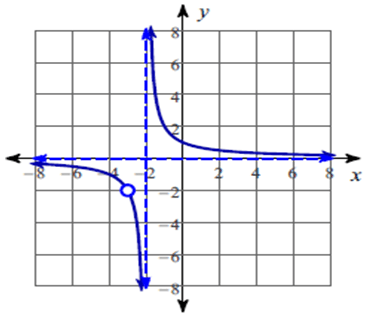
Example 5 :
f(x) = (-2x - 6)/x
Solution :
Discontinuity :
f(x) = (-2x - 6)/x
The function is discontinuous at x = 0.
Holes :
None
Vertical asymptote :
f(x) = (-2x - 6)/x
So, the vertical asymptotes at x = 0.
X – intercepts :
f(x) = (-2x - 6)/x
= -2(x + 3)/x
X – intercepts occurs when y = 0.
f(0) = -2(x + 3)/x
x + 3 = 0
x = -3
So, the x – intercepts is -3.
Horizontal asymptote :
f(x) = (-2x - 6)/x
degree
of numerator = degree of denominator
y = leading coefficient of N(x)/leading coefficient of D(x).
= -2/1
So, equation of the horizontal asymptote is y = -2.
Domain :
When x = 0
So, all real values except 0.
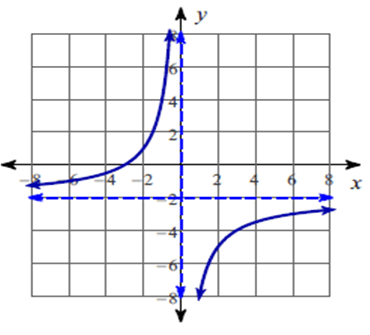
Example 6 :
f(x) = (-3x + 12)/(x – 2)
Solution :
Discontinuity :
f(x) = (-3x + 12)/(x – 2)
x – 2 = 0
x = 2
The function is discontinuous at x = 2.
Holes :
None
Vertical asymptote :
x – 2 = 0
x = 2
So, the vertical asymptote at x = 2.
X – intercepts :
f(x) = (-3x + 12)/(x – 2)
= -3(x - 4)/(x – 2)
X – intercepts occurs when y = 0.
f(0) = -3(x - 4)/(x – 2)
x - 4 = 0
x = 4
So, the x – intercepts is 4.
Horizontal asymptote :
f(x) = (-3x + 12)/(x – 2)
degree
of numerator = degree of denominator
y = leading coefficient of N(x)/leading coefficient of D(x).
= -3/1
So, equation of the horizontal asymptote is y = -3.
Domain :
When x – 2 = 0
x = 2
So, all real values except 2
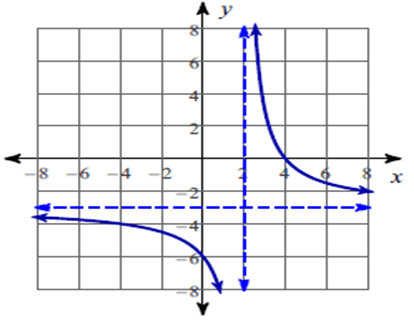
Subscribe to our ▶️ YouTube channel 🔴 for the latest videos, updates, and tips.
Recent Articles
-
Finding Range of Values Inequality Problems
May 21, 24 08:51 PM
Finding Range of Values Inequality Problems -
Solving Two Step Inequality Word Problems
May 21, 24 08:51 AM
Solving Two Step Inequality Word Problems -
Exponential Function Context and Data Modeling
May 20, 24 10:45 PM
Exponential Function Context and Data Modeling